|
For Our Tomorrows
The story of a Bomber Crew
with 149 (East India ) Sqn. R.A.F.
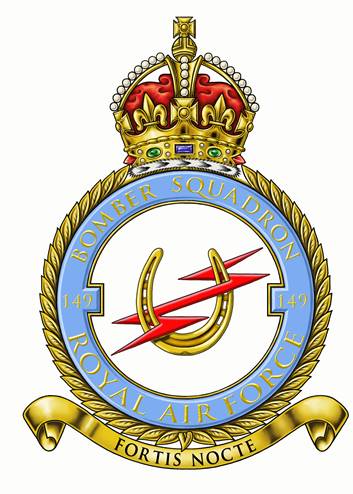
The Squadron.
"As war approached, No 149 (East India) Squadron, which had served briefly in World War I, was re-formed in 1937 at RAF Mildenhall as a night heavy bomber unit. It was initially equipped with the last RAF heavy bomber biplane, the Handley Page Heyford, but not for long. In early 1939 these were replaced with the new, geodetic structured Vickers ‘Wellingtons’. Designed by Barnes Wallis, of Dam Buster fame these were sturdy, reliable aircraft which could absorb a great amount of damage and still return home.

Wellington 1c of 149 Sqn – source unknown
Then along came the mighty Short’s Stirling Aircraft. Various constraints had turned the original design into an aircraft which was badly behaved on the ground, very manoeuvrable at low and medium altitude, but sadly deficient at its operational ceiling of twelve to fifteen thousand feet.
Looking a bit like a bulldog, with exceptionally long legs at the front, the Stirling either was loved or hated….or both depending on the latest flight. The aircraft served 149 Sqdn right up until its withdrawal from mainstream bombing in 1944, due to unacceptable losses when employed as a main stream Bomber.

After moving to Methwold the squadron finally started re-equipping with the Avro Lancaster Mk 1. This iconic Bomber was to take the Allies through to the end of the war and beyond.
The Crew
The crew were:
Flt Sgt G Roe - Pilot
Pilot Officer R Howitt - Navigator
Pilot Officer J Hoffman - Wireless Operator
Sgt D Cox - Bomb Aimer/ Mid-upper Gunner
Sgt L Bolt - Front Gunner
Sgt E Sykes - Rear Gunner
Sgt K Atkins - Flt Engineer
War Time RAF Service.
Most combatants joined the Royal Air Force as Volunteer Reservists (VR) during the 1939-45 period. For initial training they were sent to an RAF ITW or Initial Training Wing. There were around twenty of these units at any time, where the requisite number of days and weeks were devoted to injections, medical examinations and instilling the basics of service discipline into what had been, shortly before, civilian recruits. At the end of this time, the trainees would be able to march roughly in time and recognise and salute Officers when they were encountered. This Basic Training was initially carried out by regular RAF discipline (Discip) instructors, of Corporal or Sergeant rank. It was a great source of unhappiness that the recruits these regulars were training would be of a similar or higher rank than them in a relatively short time period.
At the start of the war, most pilots and observers were commissioned officers or senior NCOs. The people who flew as gunners and radio operators were normally taken from the ranks of the 'Erks' on a squadron. Aircraftman 1st and 2nd class manning the guns and/or turrets, and the radios were the 'norm'. As the war progressed and aircrew were shot down and captured, the authorities decided that they should make all flight crew a minimum rank of Sergeant, ostensibly to ensure that they were correctly treated if captured. Even then, the two groups were often split on capture into officers and NCO airmen camps.
After the basic training was accomplished, the recruits were subjected to a 'streaming' process, where their qualifications and more importantly their aptitudes were measured and considered.
Initially, these streams were either Pilot/Observer and 'the rest', who made up the crew's gunners and radio operators. Later on in the war these streams were divided into Pilot/Bomb Aimer/Navigator (PBN) and 'the rest'.
At any time during their subsequent training, the recruits could be declared unsuitable for the stream they were being trained in and then offered places in a stream where their abilities were of more use.
Sgt D R Cox was one of these Observers.
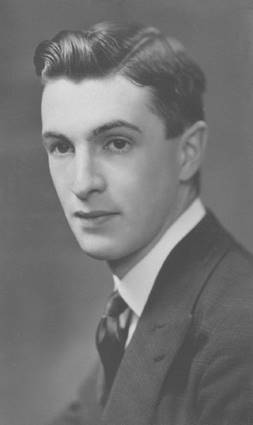
D R Cox, Observer RAFVR
Observers
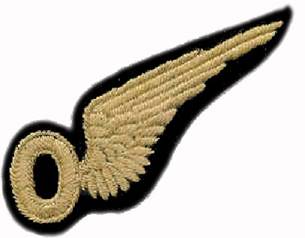
Observers were the crew who had to navigate the aircraft in conjunction with the pilot and aim the bombs to ensure the strikes were successful. They also needed a basic grounding in wireless operations and gunnery if any crew member was incapacitated and some times be able to fly the aircraft in an emergency situation.
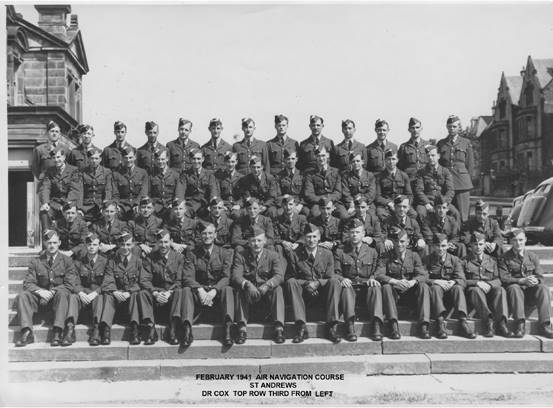
The Observer crew member position was a throwback to the first world war, when Observers (officers) were chauffeured around by Pilots (mainly NCOs).
This was when the pilot was regarded as the driver of the aircraft and the observer was the eyes, brains and the captain of the team. The observer, at the start of world war two, was the navigator and bomb aimer of the crew. As systems developed and navigational aids were increased the actual navigation of the aircraft rose in importance, as did the function of bomb aiming. In larger aircraft these positions were mutually incompatible, as the navigator needed to spend his time plotting and checking his course. The bomb aimer assisted in this with visual checks, where possible, and took over the aircraft for the bombing run, by directing the 'skipper' from his bomb aimer position.
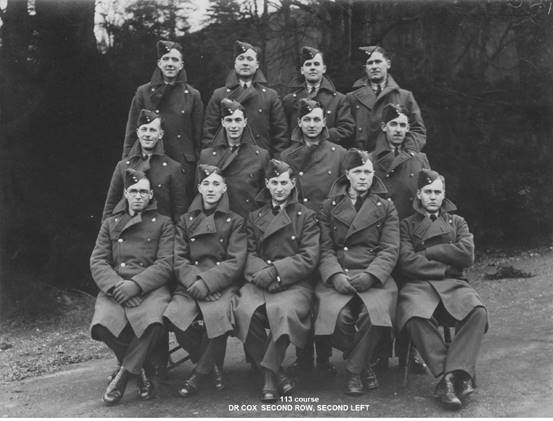
The observer/bomb aimer could not be in two places at once. This led to the demise of the treasured 'O' wing brevet and the training of two distinct and separate positions, the navigator and the bomb aimer.
Many observers fought to keep their observer brevets, despite being in receipt of training in one of the other roles.
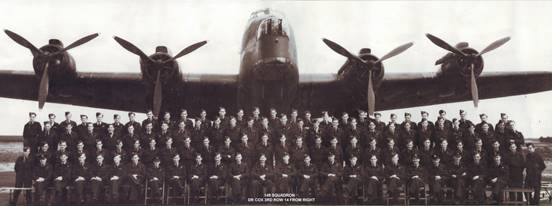
149 Sqdn aircrew. April 1943
Navigators, and Bomb Aimers eventually replaced the Observer aircrew category, as the workload required of them increased. Navigators were dedicated to the accurate navigation of the aircraft and the use of the various navigational aids fitted.
Operations.
Pilots and Observers/Navigators went to the first briefings, where the target was revealed to them. Then a litany of routes in and out, flak concentrations, bombing points, weather, latest ‘intel’, fuel loads, bomb loads and night fighter updates. Then the full crews were briefed, with wireless procedures and any other pertinent information brought to their attention.
After that the take-off times, rendezvous points and diversions were detailed. The crew now had all the information that was available to help them in their
Mission.
Sgt Douglas Richard Cox’s 149 Squadron Operational history is as follows:
1st Op - Stirling 1, Serial W7619, coded OJ-A
1st September 1942. Target: Saarbrucken.
Take Off at 23.28 from RAF Lakenheath, landing at 04.55.
Crew: Captain Squadron Leader G.A. Watt
Second Pilot Flight Sergeant G.R.B. Roe
Navigator Pilot Officer R.C. Howitt
Wireless Operator Pilot Officer J.W. Hoffman
Mid-Upper Gunner Sergeant D.R. Cox
Front Gunner Sergeant L.A. Bolt
Rear Gunner Sergeant E.W. Sykes
Flight Engineer Sergeant K.J. Atkins
Crew debrief notes from Operational Record Book (ORB):
Target SAARBRUCKEN. Nil cloud, visibility very good. 1,170 x 4lb incendiaries seen to ignite in built up area on north side of river. Centre of built up area burning well, fires were deep red. 4 bundles of nickels (pamphlets) dropped in Sarrbrucken area. Identified by loop in Saar and factory buildings S.E. of aerodrome.
Note – On this Op an experienced pilot was the aircraft Captain. This gave the ‘rookie’ crew the advantage of his experience in their first Op.
Overview of Operation from Bomber Command Diaries 1939-1945:
231 aircraft of 5 types 4 aircraft lost, 1.7% of the force. The pathfinders illuminated and marked a town which they believed to be Saarbrucken and the Main Force bombed that place vigorously. A total of 205 aircraft claimed good bombing results. But the town bombed was Saarlouis, 13 miles to north-west and situated in a similar bend in the River Saar. The small, non industrial town of Saarlouis and the villages immediately surrounding were heavily damaged. The exact extent of this damage was not recorded but 52 civilians were killed. The report from Saarlouis adds that the number of deaths would have been much higher if many people had not been able to take shelter in the unoccupied concrete positions of the Westwall (the Siegfried Line) which ran round Saarlouis. The report also says that this community was ‘enraged’ to be bombed so heavily. No bombs fell in Saarbrucken.
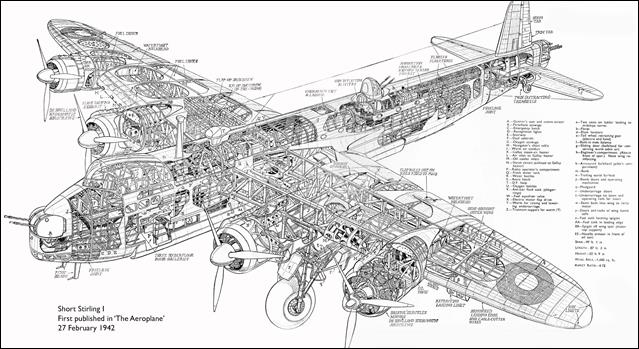
2nd Op - Stirling 1, Serial W7619, coded OJ-A
3rd September 1942. Target: Emden.
Take Off at 23.24 from RAF Lakenheath, landing at 03.28.
Crew: Captain Flight Sergeant G.R.B. Roe
Navigator Pilot Officer R.C. Howitt
Wireless Operator Pilot Officer J.W. Hoffman
Mid-Upper Gunner Sergeant L.A. Bolt
Front Gunner Sergeant D.R. Cox
Rear Gunner Sergeant E.W. Sykes
Flight Engineer Sergeant K.J. Atkins
Crew debrief notes from Operational Record Book (ORB):
Target EMDEN. 10/10 Stratus A1 tops about 11,000 ft. 8 x 1,000 lb G.P. bombed on E.T.A. Flashes counted through cloud. After bombing heavy and light flak was fired
Overview of Operation from Bomber Command Diaries 1939-1945:
11 Aircraft – 7 Wellingtons. 3 Stirlings, 1 Halifax – dispatched but could only bomb through cloud on dead reckoning-positions. 2 Wellingtons lost.
3rd Op – Stirling 1, Serial W7613, coded OJ-A
7th September 1942. Target Duisberg
Take Off at 01.30 from RAF Lakenheath,
Landing at 04.50
Crew: as for 1st Operation
Crew debrief notes from Operational Record Book (ORB):
Target EMDEN. No cloud. Visibility poor. Identified by Docks and river. 5x 200lb H.C. and explosions seen across the south side of built up area. Big red and orange fires with dense black smoke caused. Pathfinder flares and general effort widely scattered. 8 bundles of ‘Nickel’ dropped over Duisberg.
Overview of Operation from Bomber Command Diaries 1939-1945:
207 aircraft of 6 types. * aircraft – 5 Wellingtons, 1 Stirling, 3 Halifax lost. 3.9% of force – Cloud and haze were present and the bombing was not concentrated. Duisberg reported it as its heaviest raid to date, with 114 buildings destroyed and 316 seriously damaged. 86 people were killed.
4th Op - Stirling 1, Serial W7619, coded OJ-A
8th September 1942. Target: Frankfurt.
Take Off at 21.05 from RAF Lakenheath, landing at 03.03.
Crew: as for 2nd Operation
Crew debrief notes from Operational Record Book (ORB):
Target FRANKFURT. No cloud but some haze. Visibility good. Identified by river, town and islands in river.192 x 30lb incendiaries dropped, seen to ignite in built up area. Many fires seen with concentration in centre of town. Port Inner Engine caught fire but extinguished on feathering. Hit by heavy flak near ALBERT. Aircraft landed at Honington.
Overview of Operation from Bomber Command Diaries 1939-1945:
249 Aircraft of 5 types. 5 Wellingtons and 2 Halifaxes lost, 2.8% of the force. The pathfinders were unable to locate Frankfurt accurately and most of the bombing fell south-west of the city and in the town of Rűsselsheim, 15 miles away. Frankfurt reports only a few bombs, approximately 6 aircraft loads, with minor damage, 1 person dead and 30 injured. No report is available from Rűsselsheim but Bomber Command documents state that the Opel tank factory and the Michelin tyre factory were damaged.
5th Op - Stirling 1, Serial N3723, coded OJ-E
16th September 1942. Target: Essen.
Take Off at 20.49 from RAF Lakenheath,
landing at 22.41.
Crew: as for 2nd Operation
Crew debrief notes from Operational Record Book (ORB):
Target ESSEN. Target not reached as Mid Upper turret u/s. 192 x 30lb incendiaries jettisoned into the sea.
Overview of Operation from Bomber Command Diaries 1939-1945:
369 aircraft, including aircraft from the training groups. 39 aircraft – 21 Wellingtons, 9 Lancasters, 5 Stirlings, 3 Halifaxes, 1 Whitley - lost, 10.6% of the force.
Although much of the bombing was scattered, this was probably the most successful attack on this difficult target. There were 33 large and 80 ‘medium’ fires. 8 industrial and 6 transport premises were hit. The Krupps works were hit by 15 high explosive bombs and a crashing bomber loaded with incendiaries. There was much housing damage. In Essen and its immediate surroundings, 47 people were killed and 92 injured.
Many other towns were hit, in particular Bochum with 50 fires and 4 people dead, Herne with a large fire in a lorry garage and Cochem, a small town on the Moselle 90 miles south of Essen, which received 1 bomb load destroying 4 houses and killing 15 people.
6th Op - Stirling 1, Serial N3755, coded OJ-S
18th September 1942. Target: Gardening – Nectarines*.
Take Off at 19.43 from RAF Lakenheath, landing at 22.50.
Crew: as for 2nd Operation
Crew debrief notes from Operational Record Book (ORB):
Target Gardening NECTARINES. Thin layer cloud base 6,000 ft. 6 ASS32 dropped and parachutes seen to open at 5 second intervals.
Overview of Operation from Bomber Command Diaries 1939-1945:
Minelaying – 115 aircraft to many locations between Lorient and Danzig. 5 aircraft – 2 Lancasters, 2 Stirlings and 1 Wellington lost.
Note - *Gardening was the code name given to Minelaying operations. The locations where the parachute mines were dropped were given the names of fruit, vegetables and seafood. In this instance Nectarines refers to the East Frisian Islands of the North Sea coast of Germany
7th Op - Stirling 1, Serial W7619, coded OJ-A
1st October 1942. Target Lubeck
Take Off at 19.45 from RAF Lakenheath, landing at 03.06.
Crew: as for 2nd Operation
Note - For the next two operations the crew positions notations in the ORB change. Douglas Cox is noted as being Observer/Bomb Aimer (Front Gunner).
Crew debrief notes from Operational Record Book (ORB):
Target LUBECK. Encountered heavy and light flak over target area but all bombs dropped. Aircraft landed at Topcliffe.
Overview of Operation from Bomber Command Diaries 1939-1945:
25 Stirlings of 3 Group. Bombing was scattered. 3 aircraft lost.
8th Op - Stirling 1, Serial W7533, coded OJ-Q
5th October 1942. Target Aachen
Take Off at 19.29 from RAF Lakenheath, landing at 00.49.
Crew: as for 2nd Operation
Crew debrief notes from Operational Record Book (ORB):
Target AACHEN. Visibility good. Railway and built up area of town seen and identified. Bombs seen to explode in target area. Good concentration of fires in town, also several fires fairly far out from main part of town. Good fires burning as aircraft left target area.
Overview of Operation from Bomber Command Diaries 1939-1945:
257 aircraft – 101 Wellingtons, 74 Lancasters, 59 Halifaxes, 23 Stirlings. 10 aircraft – 2 Wellingtons, 1 Lancaster, 5 Halifaxes, 2 Stirlings - lost, 3.9% of the force. A further 6 aircraft crashed in England, possibly in thunderstorms which were present when some squadrons took off for the raid.
The weather continued to be bad over Germany. There was little pathfinder marking at Aachen and most of the bombing fell in other areas. Aachen reports that the raid on this night was carried out by an estimated 10 aircraft and that the centre of the attack appeared to be in the southern suburb of Burtscheid, where a 4,000lb bombe severely damaged a hospital and 2 nearby churches. 34 fires were started, 5 of them being classified as large. A moderate amount of housing was hit and, rather surprisingly, 22 industrial buildings were damaged. 5 people killed and 39 injured.
Many of the bombs intended for Aachen fell in the small Dutch town of Lutterade, 17 miles from Aachen, and it seems most of the Pathfinder marking was over this place. The Mayor of Geleen, the Dutch district in which Lutterade is now situated, reports heavy bombing and much damage in Lutterade that night. More than 800 houses were seriously damaged; 83 people were killed, 22 were injured and 3,000 were made homeless.
9th Op - Stirling 1, Serial W7619, coded OJ-A
6th October 1942. Target Osnabrook.
Take Off (T/O) at 19.30 from RAF Lakenheath, landing at 00.25.
Crew: as for 2nd Operation
Crew debrief notes from Operational Record Book (ORB):
Dummer Zee seen. Bombed on ETA. Very few fires on arrival. Incendiaries dropped but not seen, but on departure fires seen to be getting hold. Port outer cut completely as bombs were dropped. PFF flares not good at Dutch coast, better at Dummer Zee and Target.
Overview of Operation from Bomber Command Diaries 1939-1945:
237 Aircraft, 101 Wellingtons, 68 Lancasters, 38 Stirlings, 30 Halifax. 6 Aircraft lost – 2 Halifax, 2 Stirlings and 2 Lancasters. The Pathfinders succeeded in illuminating the Dummer Zee, a large lake N.E. of the target, used as a run-in point. The town of Osnabrook was then found and marked. The bombing was well concentrated, with most of the attack falling in the centre and southern parts of the target. 149 Houses destroyed, 530 seriously damaged and 2, 784 lightly damaged. 6 Industrial premises were destroyed and 14 damaged. Also hit – 6 Public buildings, 5 churches, 4 schools, 1 hospital and the local gasworks. 65 people were killed and 151 injured.
10th Op - Stirling 1, Serial N3723, coded OJ-E
23rd October 1942. Target Genoa.
Take Off (T/O) at 18.35 from RAF Lakenheath, landing at 02.26.
Crew: as for 2nd Operation
Crew debrief notes from Operational Record Book (ORB):
Target GENOA. Target identified and bombs dropped and seen to explode. Glow of several fires seen.
Overview of Operation from Bomber Command Diaries 1939-1945:
122 aircraft – 53 Halifaxes, 51 Stirlings, 18 Wellingtons. These aircraft were provided by 3 and 4 Groups. 2 Halifaxes and 1 Stirling lost.
The target was found to be almost completely cloud covered and it was later discovered that the raid had actually fallen on the town of Savona, 30 miles along the coast from Genoa. It has not been possible to obtain a report from Savona. Several aircraft bombed Turin, where 2 people were killed and 10 injured.
11th Op - Stirling 1, Serial W7638, coded OJ-R
26th October 1942. Target Gardening – ELDERBERRY*.
Take Off at 23.10 from RAF Lakenheath, landing at 06.30.
Note - * Elderberry refers to an area near Bayonne which is in south-western France at the confluence of the Nive and Adour rivers
Crew: as for 2nd Operation
Crew debrief notes from Operational Record Book (ORB):
Target Gardening ELDERBERRY. Mines laid as ordered.
Overview of Operation from Bomber Command Diaries 1939-1945:
24 Stirlings and Wellingtons from 3 Group to the Frisian Islands and Biscay ports without loss.
12th Op - Stirling 1, Serial BK597, coded OJ-F
7th November 1942. Target Genoa.
Take Off at 17.43 from RAF Lakenheath, landing at 22.40.
Crew: as for 2nd Operation
Crew debrief notes from Operational Record Book (ORB):
Target GENOA. Aircraft returned early, would not go above 12,500ft; furthest point reached 25 miles S.W. of Diton
Overview of Operation from Bomber Command Diaries 1939-1945:
175 aircraft – 85 Lancasters, 45 Halifaxes, 39 Stirlings, 6 Wellingtons. 6 aircraft – 4 Halifaxes, 1 Lancaster, 1 Wellington lost 3.4% of the force.
Returning crews claimed a very successful and concentrated raid and this was confirmed by photographs. No report is available from Genoa.
13th Op - Stirling 1, Serial W7639, coded OJ-Q
10th November 1942. Target Gardening – Nectarines (Borkum). Take Off at 17.56 from RAF Lakenheath, landing at 21.38.
Crew: as for 2nd Operation
Crew debrief notes from Operational Record Book (ORB):
Target Gardening NECTARINES 111. Mines laid as ordered.
Overview of Operation from Bomber Command Diaries 1939-1945:
42 aircraft to the southern Biscay coast of France and to the Frisian Islands. No aircraft were lost but 2 Lancasters crashed in England.
14th Op - Stirling 1, Serial W7619, coded OJ-A
23rd November 1942. Target Stuttgart. Take Off at 18.46 from RAF Lakenheath, landing at 20.35.
Crew: as for 2nd Operation
Crew debrief notes from Operational Record Book (ORB):
Target STUTTGART. Aircraft returned as rear turret u/s. Incendiaries jettisoned. After touching down aircraft gave a violent swing to starboard. Port main wing, airscrews, undercarriage, port tail plane smashed. Furthest point reached Dungeness.
Overview of Operation from Bomber Command Diaries 1939-1945:
222 aircraft – 97 Lancasters, 59 Wellintons, 39 Halifaxes, 27 Stirlings. 10 aircraft – 5 Lancasters, 3 Wellingtons, 2 Halifaxes – lost. 4.5% of the force.
A thin layer of cloud and some ground haze concealed Stuttgart and the pathfinders were not able to identify the centre of the city. Heavy bombing developed towards the south-west and south and the outlying residential districts of Vaihingen, Rohr, Mohringen and Plieningen, all about 5 miles from the centre, were hit. 88 houses were destroyed and 334 seriously damaged; 28 people were killed and 71 injured. The Stuttgart report says that 2 bombers attacked the city centre at low level and dropped bombs on the main railway station which caused severe damage to the wooden platforms and some trains in the station.
15th Op - Stirling 1, Serial R9253, coded OJ-C
28th November 1942. Target Turin. Take Off at 19.13 from RAF Lakenheath, landing at 00.50.
Crew: Captain Flight Sergeant G.R.B. Roe
Navigator Sergeant J.E. Hart
Wireless Operator Pilot Officer J.W. Hoffman
F.Gunner/Bomb Aimer Sergeant D.R. Cox
Mid-Upper Gunner Sergeant L.A. Bolt
Rear Gunner Sergeant E.W. Sykes
Flight Engineer Sergeant K.J. Atkins
Crew debrief notes from Operational Record Book (ORB):
Target TURIN. Aircraft returned as port outer engine u/s. Jettisoned bombs. Safe, Orfordness 3 mile E0001 2000. Brought back 3 x 1000. Furthest point reached 47.44 0436E.
Overview of Operation from Bomber Command Diaries 1939-1945:
229 aircraft – 117 Lancasters, 47 Stirlings, 45 Halifaxes, 19 Wellingtons. 2 Stirlings and 1 Wellington lost.
Part of the the force bombed before the Pathfinders were ready but the remainder carried out very accurate bombing, some of it around the Royal Arsenal. Wing commander G.P. Gibson and Flight lieutenant W.N. Whamond of 106 Squadron dropped the first 8,000lb bombs on Italy. Turin recorded 67 people killed and 83 injured.
Note – This was the raid in which P.O. Rawdon Middleton of 149 Sqn won his V.C.
16th Op - Stirling 1, Serial R9253, coded OJ-C
29th November 1942. Target Turin. Take Off at 00.18 from RAF Lakenheath, landing at 02.16.
Crew: as for 13th Operation.
Crew debrief notes from Operational Record Book (ORB):
Target TURIN. Returned early due to severe icing. Bombs jettisoned safe.
Overview of Operation from Bomber Command Diaries 1939-1945:
29 Stirlings and 7 Lancasters of £ Group and the Pathfinder Force dispatched, with the Fiat works as their main target. Weather conditions were poor and only 18 aircraft, 14 Pathfinders and 4 Stirlings of 3 Group, are known to have definitely crossed the Alps and bombed Turin. 2 further Stirlings were lost. Turin can report only that 16 people were killed and 15 injured.
17th Op - Stirling 1, Serial R9242, coded OJ-B
16 December 1942. Target Gardening Deodars*.
Take Off at 22.06 from RAF Lakenheath, landing at 04.14.
Note - * Deodars refers to an area in the Gironde Estuary near Bordeaux.
Crew: as for 13th Operation.
Crew debrief notes from Operational Record Book (ORB):
Target Gardening DEODARS. Mines laid as ordered.
Overview of Operation from Bomber Command Diaries 1939-1945:
18 aircraft minelaying in the River Gironde and off Brest and Lorient; 1 Stirling lost
18th Op - Stirling 1, Serial BK612, coded OJ-E
15 January 1943. Target Lorient. Take Off at 18.05 from RAF Lakenheath, landing at -.
Crew: as for 13th Operation with the addition of Flying Officer H.L. Saunders as 2nd pilot.
Crew debrief notes from Operational Record Book (ORB):
Aircraft landed at Bassingbourne immediately after take off owing to engine failure. Bombs jettisoned at Royston Heath.
Overview of Operation from Bomber Command Diaries 1939-1945:
157 aircraft – 65 Wellingtons, 48 Halifaxes, 40 Stirlings, 4 Lancasters. 1 Stirling and 1 Wellington lost.
Bombing was more accurate than on previous night. At least 800 buildings were destroyed and 12 civilians killed. Most of the inhabitants had fled the town during the previous day.
19th Op - Stirling 1, Serial R9203, coded OJ-D
4th February 1943. Target Turin. Take Off at 18.06 from RAF Lakenheath, landing at 02.04.
Crew: as for 13th Operation.
Crew debrief notes from Operational Record Book (ORB):
Target TURIN. Visibility good. Town was in bomb sight, bombs believed to have fallen near A.P. One good fire near to river, east of marshalling yards. A number of scattered fires seen. Rear turret oil pipe burst.
Overview of Operation from Bomber Command Diaries 1939-1945:
188 aircraft – 84 Halifaxes, 66 Stirlings, 62 Lancaster, 51 Wellingtons – provided by all Groups on the first 200 plus raid for more than 2 weeks.
20th Op - Stirling 1, Serial BF444, coded OJ-G
7th February 1943. Target Lorient. Take Off at 19.10 from RAF Lakenheath, landing at 20.46.
Crew: as for 13th Operation.
Crew debrief notes from Operational Record Book (ORB):
Target LORIENT. Aircraft returned early as undercarriage would not retract electrically and by hand it stuck half way. 3 x 1000 jettisoned safe. 1 x 1000 exploded. 1440 x 4lb jettisoned Burnham Flats. Aircraft did not cross coast.
Overview of Operation from Bomber Command Diaries 1939-1945:
323 aircraft – 100 Wellingtons, 81 Halifaxes, 80 Lancasters, 62 Stirlings. 7 aircraft 3 Lancasters, 2 Halifaxes, 2 Wellingtons – lost.
The Pathfinder marking plan worked well and the two Main Force waves produced a devastating attack.
21st Op - Stirling 1, Serial EF328, coded OJ-S
26th February 1943. Target Nuremburg. Take Off at 19.46 from RAF Lakenheath, landing at 03.18.
This was a ‘spare’ trip done by Doug as Bomb Aimer for the crew of Fg Off Ellis.
22nd Op - Stirling 1, Serial EF328, coded OJ-S
28th February 1943. Target St Nazaire. Take Off at 18.34 from RAF Lakenheath, landing at 23.55.
Crew: Captain Flying Officer G.I. Ellis
Screen Pilot Officer J.J. Needham
Navigator Sergeant E. Booth
Wireless Operator Sergeant E.R. Ginn
Bomb Aimer Sergeant D.R. Cox
Mid Upper Sergeant F. Sheppard
Flight Engineer Sergeant V.J. Upson
Rear Gunner Sergeant P.B. Mills
Crew debrief notes from Operational Record Book (ORB):
Target ST. NAZAIRE. Visibility good. Town clearly seen by light of fires. Bombed on green T.I.markers. Whole town in concentrated flames. Port tail plane holed due to flak.
Overview of Operation from Bomber Command Diaries 1939-1945:
Having destroyed Lorient, Bomber Command was now ready to start on the second target on the list of French U-boat base ports which the directive of 14th January had ordered to be destroyed. 437 aircraft – 152 Lancasters, 119 Wellingtons, 100 Halifaxes, 62 Stirlings, 4 Mosquitoes – were dispatched. 2 Lancasters, 2 Wellingtons, 1 Stirling – were lost, 1.1% of the force.
This initial raid caused widespread destruction. Local reports say that many bombs fell into the town and that 60% of the town was destroyed. 29 people are reported as being killed and 12 injured; it is presumed that most of the local population had left the town.
23rd Op - Stirling 1, Serial EF328, coded OJ-S
1st March 1943. Target Berlin. Take Off at 18.45 from RAF Lakenheath, landing at xxxxx.
24th Op - Stirling 1, Serial EF328, coded OJ-S
3rd March 1943. Target Hamburg. Take Off at 18.25 from RAF Lakenheath, landing at 23.50.
Crew: Captain Flying Officer G.I. Ellis
Navigator Sergeant E. Booth
Wireless Operator Sergeant E.R. Ginn
Bomb Aimer Sergeant D.R. Cox
Mid Upper Sergeant F. Sheppard
Flight Engineer Sergeant V.J. Upson
Rear Gunner Sergeant P.B. Mills
Crew debrief notes from Operational Record Book (ORB):
Target HAMBURG. Visibility good. Red and green T.I. markers in bomb sight. About 20 good fires were seen after leaving target. One exceptionally large one emitting thick black smoke. The attack seemed to be developing quite well. R/turret clear vision panel and port aileron damaged by flak.
Overview of Operation from Bomber Command Diaries 1939-1945:
417 aircraft – 149 Lancasters, 123 Wellingtons, 83 Halifaxes, 62 Stirlings. 10 aircraft – 4 Lancasters, 2 Wellingtons, 2 Halifaxes, 2 Stirlings – lost, 2.4% of the force
Visibility was clear over the target but the Pathfinders made a mistake, possibly thinking that the H2S indications of mudbanks in the Elbe, which had been uncovered by the low tides, were sections of the Hamburg docks. Most of the Main Force bombing thus fell 13 miles downstream from the centre of Hamburg around the small town of Wedel. Even so a proportion of the bombing force did hit Hamburg which suffered 27 people killed and 95 injured and whose fire brigade had to put out 100 fires before devoting all its energies to helping the town of Wedel, which suffered so heavily. The damage at Wedel included a large naval clothing store burnt out as well as several important industrial concerns destroyed in Wedel’s harbour area and this illustrated another Bomber Command view: that bombing could usually be useful even if the wrong target was hit.
25st Op - Stirling III, Serial BK698, coded OJ-O
5th March 1943. Target Essen. Take Off at 19.32 from RAF Lakenheath, landing at 22.16.
Crew: Captain Flying Officer G.I. Ellis
Navigator Sergeant E. Booth
Wireless Operator Sergeant E.R. Ginn
Bomb Aimer Sergeant D.R. Cox
Mid Upper Sergeant F. Sheppard
Flight Engineer Sergeant F.L. Kelly
Rear Gunner Sergeant P.B. Mills
Crew debrief notes from Operational Record Book (ORB):
Target ESSEN. Krupps Works. 2/10ths cloud. Red T.I’s in centre of green concentration were in bomb sight. Numerous good red fires, buildings could be seen burning. Two terrific explosions in the centre of fires. “If target indicators were correctly placed Krupps had definitely ‘had it’”

Overview of Operation from Bomber Command Diaries 1939-1945:
442 aircraft – 157 Lancasters, 131 Wellingtons, 94 Halifaxes, 52 Stirlings, 8 Mosquitoes. It was on this night that bomber Commands 100,000th sortie of the war was flown. 14 aircraft - 4 Lancasters, 4 Wellingtons, 3 Halifaxes, 3 Stirlings- lost, 3.2% of the force.
The only tactical setback to this raid was that 56 aircraft – nearly 13% of the force – turned back early because of technical defects and other causes. 3 of the ‘early returns’ were from the 8 Oboe Mosquito marker aircraft upon which the success of the raid depended but the 5 Mosquitoes which did reach the target area opened the attack on time and marked the centre of Essen perfectly. The Pathfinder backers-up also arrived in good time and carried out their part of the plan. The whole of the marking was ‘blind’, so that the ground haze which normally concealed Essen did not affect the outcome of the raid. The Main force bombed in 3 waves – Halifaxes in the first wave, Wellingtons and Stirlings in the second and Lancasters in the third. Two thirds of the bomb tonnage was incendiary; one third of the high explosive bombs were fuzed for long delay. The attack lasted for 40 minutes and 362 aircraft claimed to have bombed the main target. These tactics would be typical of many other raids in the Ruhr area in the next 4 months.
Reconnaissance photographs showed 160 acres of destruction with 52 separate buildings within the Krupps works hit by bombs. A map from Essen shows the main area of damage to have been between the Krupps works and the city centre. The local report states that 3,018 houses were destroyed and 2,166 seriously damaged. The number of people killed is given in various reports as between 457 and 482; at least 10 of these were firemen. If the higher figure is correct, the previous record number of people killed in an air raid on Germany – 469 in the 1,000 bomber raid on Cologne in May 1942 – was exceeded.
26th Op - Stirling III, Serial BK698, coded OJ-O
22nd March 1943. Target St. Nazaire. Take Off at 19.05 from RAF Lakenheath, landing at 22.51.
Crew: as for 21st Operation.
Crew debrief notes from Operational Record Book (ORB):
Target ST. NAZAIRE. Aircraft took off but was recalled before target reached.
Overview of Operation from Bomber Command Diaries 1939-1945:
357 aircraft – 189 Lancasters, 99 Halifaxes, 63 Stirlings, 6 Mosquitoes. 1 Lancaster lost.
3 Group sent out a recall order to its Stirlings and only 8 carried on to bomb the target. Accurate marking led to a concentrated attack by 283 aircraft on the port area of St.Nazaire
27th Op - Stirling III, Serial BK698, coded OJ-O
4th April 1943. Target Kiel. Take Off at 20.40 from RAF Lakenheath, landing at 01.59.
Crew: as for 21st Operation.
Crew debrief notes from Operational Record Book (ORB):
Target KIEL. Cloud top 4,000. Yellow markers on coast. Red and green markers seen on run in. Red markers seen in bombsight. Good glow beneath cloud seen on crossing coast.
Overview of Operation from Bomber Command Diaries 1939-1945:
577 aircraft – 203 Lancasters, 168 Wellingtons, 116 Halifaxes and 90 Stirlings – on the largest raid so far to Kiel, more than twice as many aircraft as on any previous raid taking part. This was also the largest ‘non-1,000’ bombing force of the war so far. 12 aircraft – 5 Lancasters, 4 Halifaxes, 2 Stirlings, 1 Wellington – lost, 2.1% of the force.
The pathfinders encountered thick cloud and strong winds over the target so that accurate marking became very difficult. It was reported that decoy fire sites may also have drawn off some of the bombing. Kiel reports only a few bombs in the town with 11 buildings destroyed, 486 damaged and 26 people killed. No commercial premises were hit; the only building hit apart from houses was a catholic church.
28TH Op - Stirling III, Serial BK698, coded OJ-O
8th April 1943. Target Duisburg. Take Off at 21.53 from RAF Lakenheath, landing at 01.49.
Crew: as for 21st Operation with the addition of Sergeant J.H. Uden as 2nd Pilot
Crew debrief notes from Operational Record Book (ORB):
Target DUISBURG. Ruhr Area. Cloud tops above 17,000 feet. Bombed on ETA. No PFF Markers or Flares seen. Impossible to see anything.
Overview of Operation from Bomber Command Diaries 1939-1945:
392 aircraft – 156 Lancasters, 97 Wellingtons, 73 Halifaxes 56 Stirlings, 10 Mosquitoes. 19 aircraft – 7 wellingtons, 6 Lancasters, 3 Halifaxes, 3 Stirlings lost – 4.8% of the force.
Thick cloud again ruined the Pathfinder marking and the resultant bombing was widely scattered. Duisburg experienced only moderate damage, with 40 buidings destroyed, 72 seriously damaged and 36 people killed. Bombs fell on at least 15 other towns in the Ruhr.
Next Op – 10th Mar ’44 15 Sqn.
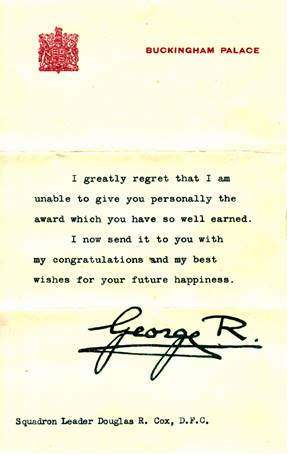 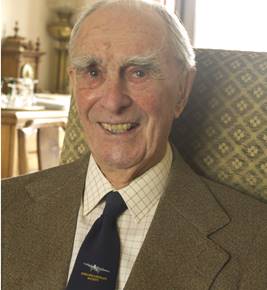
So ended Doug Cox's time with 149 (East India) Squadron. He survived the war and had a long and fruitful life.
|
 Stirling Pilott
Stirling Pilott 
 Stirling Pilott
Stirling Pilott 